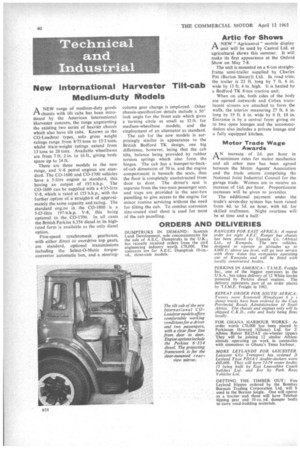New International Harvester Tilt-cab Medium-duty Models
Page 42

If you've noticed an error in this article please click here to report it so we can fix it.
ANEW range of medium-duty goods chassis with tilt cabs has been introduced by the American International Harvester concern, the range augmenting the existing two series of heavier chassis which also have tilt cabs. Known as the CO-Loadstar types, solo gross weight ratings range from 8.75 tons to 12.3 tons, whilst train-weight ratings extend from 13 tons to 20 tons. Available wheelbases are from 7 ft. 2 in. to 16 ft., giving body space up to 24 ft.
There are three models in the new range, and V-8 petrol engines are standard. The CO-1600 and CO-1700 vehicles have a 5-litre engine as standard, this having an output of 193 b.h.p. The CO-1600 can be supplied with a 4.35-litre V-8, which is rated at 155 b.h.p., with the further option of a straight-6 of approximately the same capacity and rating. The standard eng:ne in the CO-1800 is a 5-65-litre 197-b.h.p. V-8, this being optional in the. CO-1700. In all cases the British Perkins 6.354 diesel in its highrated form is available as the only diesel option.
Five-speed synchromesh gearboxes, with either direct or overdrive top gears, are standard, optional transmissions including the Select-O-Matic torqueconvertor automatic box, and a steering
column gear change is employed. Other chassis-specification details include a 50° lock angle for the front axle which gives a turning circle as small as 32 ft. for medium-wheelbase models, and the employment of an alternator as standard.
The cab for the new models is surprisingly similar in appearance to the British Bedford TK design, one big difference, however,. being that the cab tilts, balance being provided by rubber torsion springs which also form the hinges. The cab has a bumper-to-backof-cab dimension of 70 in. and the engine compartment is beneath the seats, thus the floor is completely unobstructed from door to door. The driver's seat is separate from the two-man passenger seat, and traps are provided in the seat-box panelling to give access to the engine for minor routine servicing without the need for tilting the cab. To combat corrosion zinc-coated steel sheet is used for most of the cab panelling.








































































































